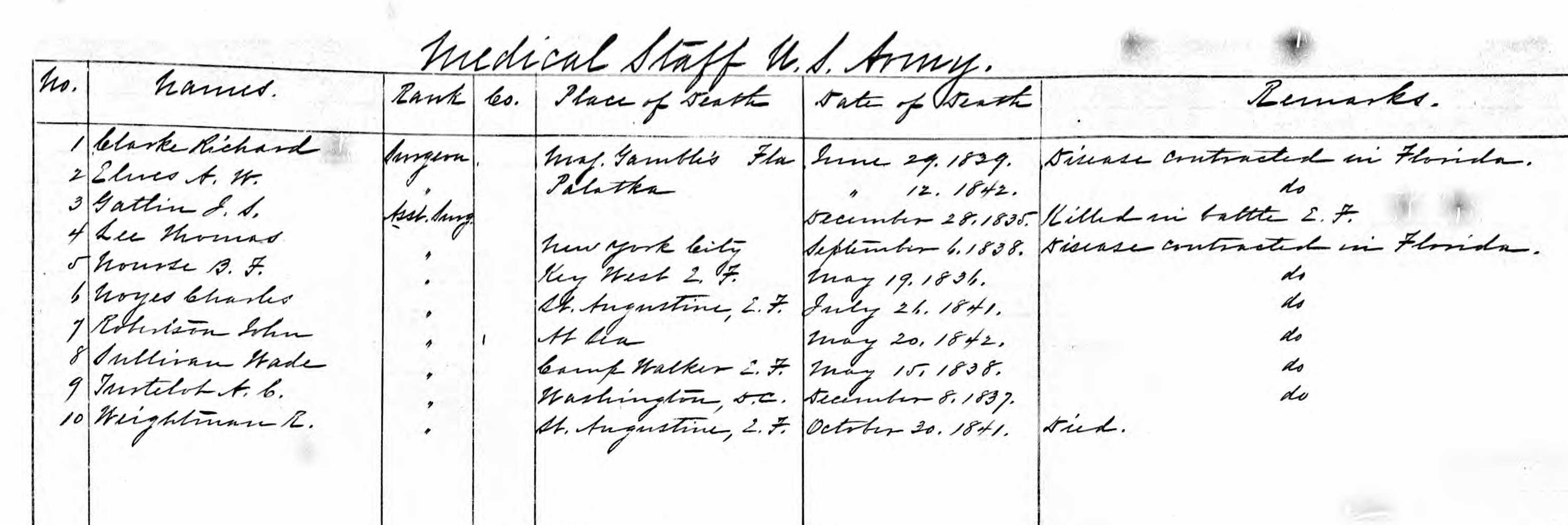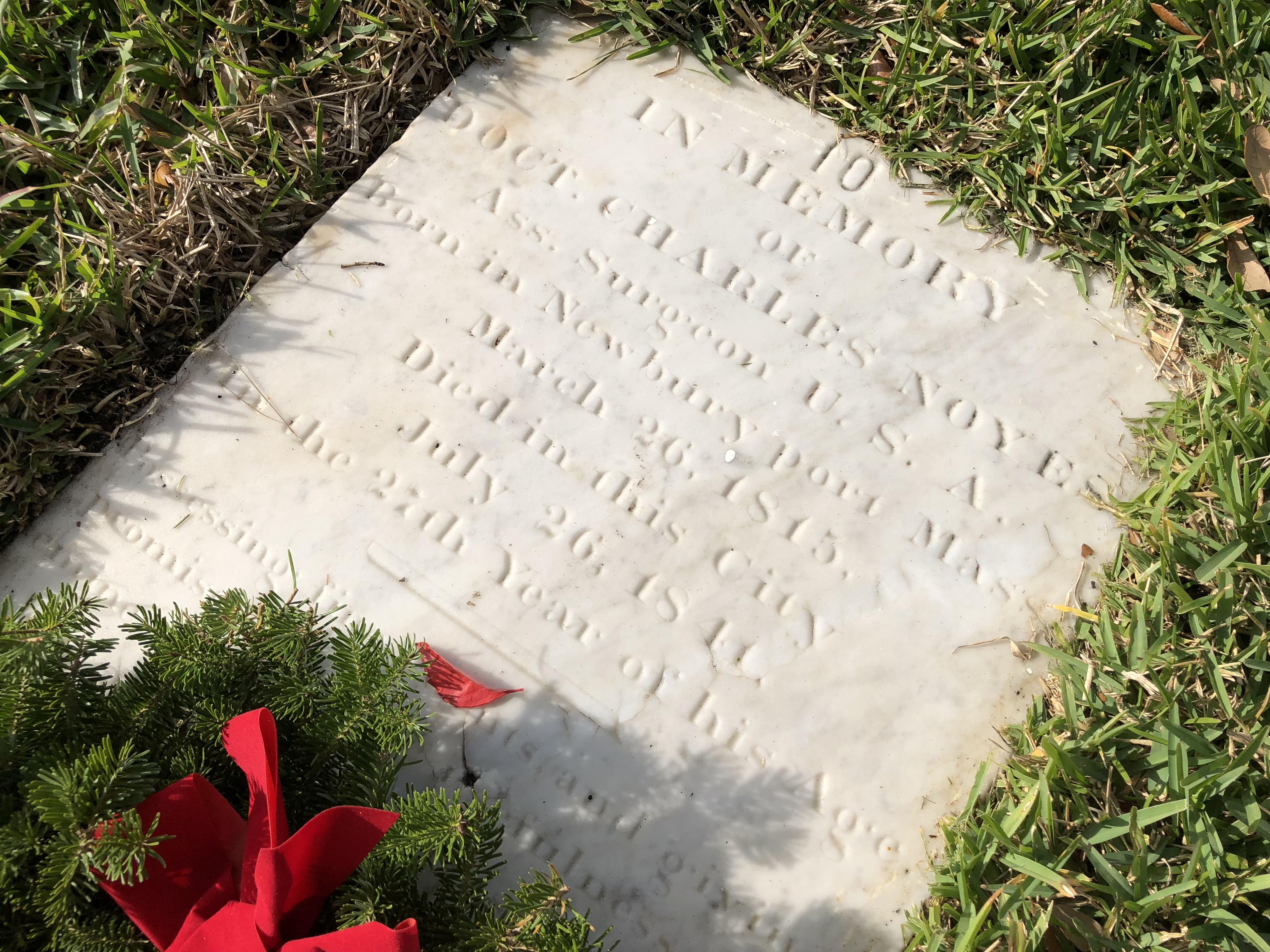Charles Noyes (March 26, 1815–July 26, 1841)
By Rhiannon O’Neil
Early Life
Charles Noyes was born on March 26, 1815, to William and Mary Noyes in Newburyport, Massachusetts.1 He was the second of seven children; the others were William, Mary E., Maria, Emily, Henry, and an unknown third brother.2 By 1830, the family had moved to Washington, D.C.3 In 1835, at the age of twenty, Noyes graduated from the University of Pennsylvania as a Doctor of Medicine.4
Military Service
After the United States acquired Florida in 1819, the federal government put increasing pressure on the Seminole Tribe to relocate west of the Mississippi River to the Oklahoma Territory. In 1832, many tribal leaders met with representatives from the U.S. federal government at Payne’s Landing and agreed to survey the land in the Oklahoma Territory for suitability. In 1833 these leaders signed what they assumed was a fair agreement. However, other leaders who did not travel west refused to abide by the treaty and remained in their reservation north of Lake Okeechobee in Florida.5
The Second Seminole War started in December 1835 with an attack by Seminole warriors upon Maj. Francis L. Dade’s company as they were traveling from Fort Brooke to Fort King. All but three of the 107 soldiers traveling with Dade’s Command were killed.6 The Second Seminole War lasted until 1842 and was the costliest war with Native Americans fought by the U.S. government.7
In December 1838, Dr. Noyes first appears in Florida military records, listed as an assistant surgeon.8 It is likely that Noyes came into this position under contract due to a shortage of surgeons throughout the war.9 He was originally stationed at Fort Gatlin.10 The records show that Noyes remained at Fort Gatlin until at least June 1839.11 By June 1840, he was stationed at Fort New Smyrna on the east coast of Florida.12 It is unclear where he was in the intervening year. During his time spent at the two forts, however, it is likely that he dealt with many injuries, deaths, and diseases. Because of the shortage of surgeons in Florida, those who were hired often attended to many patients. Many surgeons themselves contracted diseases while tending to their sick and wounded.13
Dr. Noyes remained at Fort New Smyrna until June 1841.14 During this month, he contracted a disease, listed as a “fever” in The Evening Post.15 He died the next month in St. Augustine and was interred in the national cemetery there.16 “By strangers honor’d,” his plaque reads, “and by strangers mourned.”17 After his death, to “respect…his memory,” the officers in St. Augustine wore “crape for one month.”18 He was one of ten “officers belonging to the Medical Staff of the United States Army, who died from disease and other causes, from service in Florida.”19
Endnotes
1 “Charles Noyes” database, Veterans Legacy Memorial (https://www.vlm.cem.va.gov/0875/CHARLESNOYES/BA6D798/ : accessed November 21, 2019).; “Charles Noyes” database, <a>FindAGrave.com. (https://www.findagrave.com/memorial/3964815 : accessed May 30, 2019).; “Charles Noyes” database, Ancestry.com. (https://www.ancestry.com/ : accessed May 30, 2019), Family Tree.
2 “Charles Noyes” database, Ancestry.com. (https://www.ancestry.com/ : accessed May 30, 2019), Family Tree.; “West Newbury, Essex, Massachusetts 1820 United States Federal Census” database, Ancestry.com. (https://www.ancestry.com/ : accessed May 30, 2019), entry for William Noyes.
3 “Georgetown, Washington, District of Columbia 1830 United States Federal Census” database, Ancestry.com. (https://www.ancestry.com/ : accessed May 30, 2019), entry for Wm Noyes.
4 “U.S. College Student Lists, 1763-1924” database, Ancestry.com. (https://www.ancestry.com/ : accessed May 30, 2019), entry for Charles Noyes.
5 “The Seminole Wars,” Seminole National Museum, last modified 2012, https://www.seminolenationmuseum.org/history/seminole-nation/the-seminole-wars/.
6 “Dade’s Battle (December 28, 1835),” Florida Memory Blog. (https://www.floridamemory.com/ : last modified November 15, 2013).
7 “The Seminole Wars,” Seminole National Museum, last modified 2012, https://www.seminolenationmuseum.org/history/seminole-nation/the-seminole-wars/.
8 “U.S. Returns from Military Posts, 1806-1916” database, Ancestry.com. (https://www.ancestry.com/ : accessed May 29, 2019), entry for Charles Noyes in 1838.
9 Mary C. Gillett, “Indian Removal in the Southeast: The Second Seminole War,” in The Army Medical Department, 1818-1865 (Washington: Government Printing Office, 1987), 59-61, https://history.amedd.army.mil/booksdocs/civil/gillett2/amedd_1818-1865_chpt3.html.
10 Named for Assistant Surgeon John Gatlin, who perished in the 1835 Dade Massacre, the fort was established in November 1838. The site was chosen for its vantage point at the highest of three hills in the area, as well as being a place frequented by Seminoles. It remained in active use until 1849. Thomas Cook, “Fort Gatlin Historic Marker Sign, 2004,” RICHES, accessed May 30, 2019, https://richesmi.cah.ucf.edu/omeka/items/show/2070.
11 “U.S. Returns from Military Posts, 1806-1916” database, Ancestry.com. (https://www.ancestry.com/ : accessed May 29, 2019), entry for Charles Noyes in 1839.
12 “U.S. Returns from Military Posts, 1806-1916” database, Ancestry.com. (https://www.ancestry.com/ : accessed May 29, 2019), entry for Charles Noyes in 1840.
13 Mary C. Gillett, “Indian Removal in the Southeast: The Second Seminole War,” in The Army Medical Department, 1818-1865 (Washington: Government Printing Office, 1987), 60-61, 66-68, https://history.amedd.army.mil/booksdocs/civil/gillett2/amedd_1818-1865_chpt3.html.
14 “U.S. Returns from Military Posts, 1806-1916” database, Ancestry.com. (https://www.ancestry.com/ : accessed May 29, 2019), entry for Charles Noyes in 1841.
15 “The Evening Post” database, Newspapers.com. (https://www.newspapers.com/ : August 7, 1841), entry for Florida, July 28, 1841.
16 Although the control form indicated Noyes is in the pyramids, he was buried in Section A, site 10, before the pyramids were constructed. “St. Augustine, U.S. National Cemetery Interment Control Forms, 1928-1962” database, Ancestry.com. (https://www.ancestry.com/ : accessed May 29, 2019), entry for Charles Noyes.
17 “Charles Noyes” database, FindAGrave.com. (https://www.findagrave.com/memorial/3964815 : accessed May 30, 2019).
18 “From the National Intelligencer,” in Army and Navy Chronicle, and Scientific Repository, Vol. XII, No. 35, ed. Benjamin Homans (T. Barnard, 1841), 274.
19 John T. Sprague, “Appendix,” in The origin, progress, and conclusion of the Florida War; to which is appended a record of officers, non-commissioned officers, musicians, and privates of the U.S. Army, Navy, and Marine Corps, who were killed in battle, or died of disease. As also the names of officers who were distinguished by brevets, and the names of others recommended. Together with the order for collecting the remains of the dead in Florida, and the ceremony of interment at St. Augustine, East Florida, on the fourteenth day of August, 1842 (New York: D. Appleton & Co.; Philadelphia: Geo. S. Appleton, 1848) 548, https://archive.org/details/originprogressco00inspra/page/548.
© 2019, University of Central Florida




